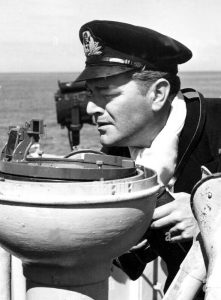
Commander George Ericson is crouched on the bridge of his corvette warship. He’s peering through a sighting device, lining up his counterattack against an enemy he can’t see, a submerged U-boat in the Atlantic waters directly ahead of him.
“What’s it look like now, Number One?” Ericson calls to his first officer, who is on a sonar device.
“It’s the firmest contact we’ve ever had,” the sonar operator shouts back from below deck.
There’s sudden consternation on Cmdr Ericson’s face. Merchant sailors whose ship has just been torpedoed are thrashing about in the water. They’re shouting for help. “There’s men in the water just about there,” Ericson says.
“Well, there’s a U-boat just underneath them.”
It happened repeatedly. Commanders of wartime escort ships on the North Atlantic in the Second World War saw merchant ships exploding all around them. They called their crews aboard corvette warships to battle stations. They tracked down submerged German U-boats using primitive sonar detecting devices and dropped explosive depth charges to fight back.
Then, far too often, the corvette commanders realized the U-boats chose to hide beneath the Allied sailors whose ships they’d just sunk.
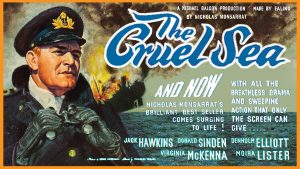 With Remembrance Day approaching, the Roxy Theatres have agreed to bring the story of Cmdr Ericson – a fictional character based on Nicholas Monsarrat’s novel The Cruel Sea – for a special screening of The Cruel Sea movie on Wednesday evening, Nov. 1.
With Remembrance Day approaching, the Roxy Theatres have agreed to bring the story of Cmdr Ericson – a fictional character based on Nicholas Monsarrat’s novel The Cruel Sea – for a special screening of The Cruel Sea movie on Wednesday evening, Nov. 1.
(Full disclosure. I have spent the past several years crisscrossing the country speaking about the Battle of the Atlantic to hundreds of audiences. Cathy Christoff and I felt this would be an appropriate way to pay tribute to this community’s veterans.)
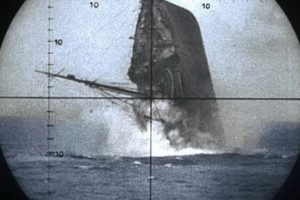
In the fall of 1942, the U-boat wolf packs had Allied shipping by the throat. Attempting to keep vital supplies of food, fuel and survival goods flowing to Britain’s 41 million civilians, Canada’s (and other Allied nations’) merchant ships were sinking in horrendous numbers. U-boats sank 95 Allied merchant ships on the North Atlantic in September, 62 in October and 83 in November – over a million tons of fuel and freight to the bottom.
Even worse, Canadian Merchant Navy sailors were dying under the most adverse conditions imaginable – 12,000 of them during the battle – alone in freezing temperatures, choking on oil-soaked waters or burned by torpedo exposives.
Among them was 26-year-old Charles Goodspeed aboard the merchant steamship Bic Island. Told not to stop for anything, Goodspeed and his shipmates had slowed to pick up survivors of other torpedoed ships in Convoy HX 212. But U-boats closed in and fired on Bic Island too; 165 officers and crew, including Goodspeed, died in the battle.
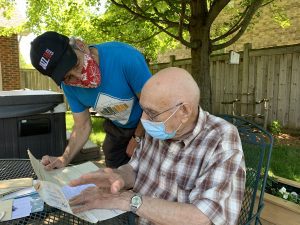
Some years ago, I met Charles Goodspeed’s nephew. Norman Goodspeed – a longtime Uxbridge resident now in his 90s – who served aboard the Canadian destroyer HMCS Saguenay. He was so eager to serve during WWII that he joined the Royal Canadian Navy underage.
“I got my sister to erase 1927, and put in 1926, so I’d be eligible to join,” he told me.
Norman Goodspeed joined in Saint John, N.B., completed his basic training in Windsor, but eventually was posted to supply division aboard HMCS Saguenay. So eager was Norman to get into the action, after V-E Day (when the war ended in Europe), he volunteered for service in the Pacific, but meantime the Allies dropped atomic weapons on Japan.
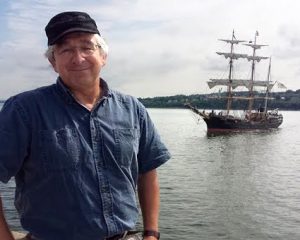
I’d always wondered about the way motion picture producers attempt to depict wartime stories such as the Battle of the Atlantic. I learned how, when I met Royal Canadian Navy lieutenant (retired) Gordon Laco. Also an accomplished naval historian, Laco was invited by Tom Hanks and the producers of the more recent Battle of the Atlantic movie, Greyhound, to ensure the movie captured combat on the North Atlantic accurately.
“Mr. Hanks wanted to get it right,” Laco said. “We truly felt (the veterans were) looking over our shoulders as we choreographed the action sequences … and described how people lived and died at sea during those terrible years.”
Veteran Norman Goodspeed and naval adviser Gordon Laco will join us at the Roxy Theatres at 6:30 p.m, on Nov. 1, when I interview them and we screen the movie The Cruel Sea, depicting the longest continuous military action of the Second World War – the Battle of the Atlantic.
Fictional Cmdr Ericson, played by Jack Hawkins in 1953 movie, sets the scene aptly:
“This is the story of the Battle of the Atlantic. It’s the story of an ocean, two ships and a handful of men. The men are the heroes. The heroines are the ships. The only villain is the sea, the cruel sea, that man has made more cruel.”